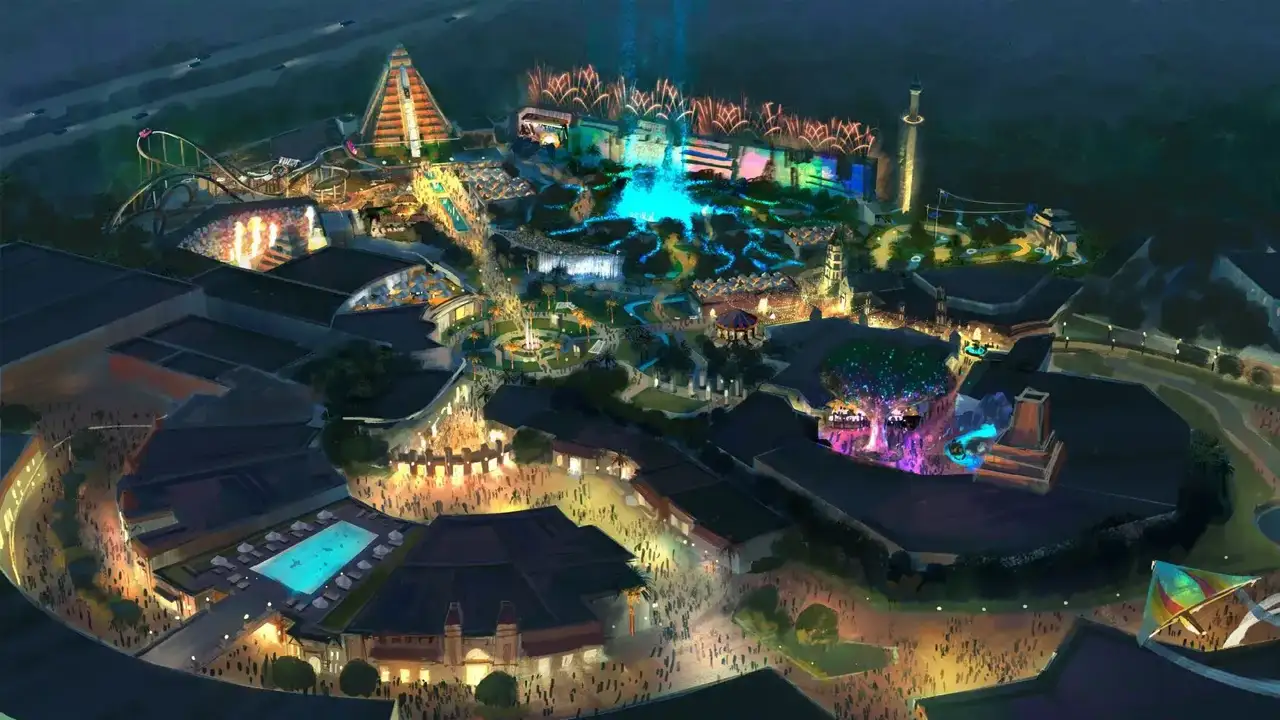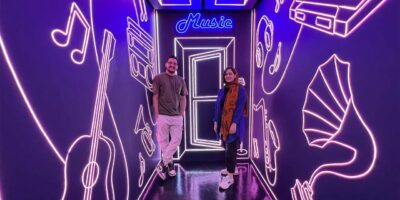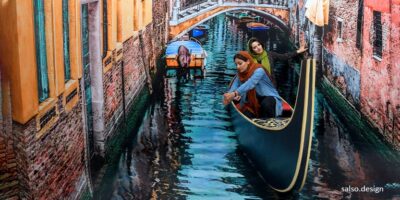At Salso Design studio, we don’t just create theme parks—we craft unforgettable adventures. A theme park isn’t just a random collection of rides and fancy walls; it’s the careful planning of every moment that separates ‘meh’ from ‘mind-blowing.’ Our expert team maps out every sight, sound, and sensation so visitors are fully immersed from the moment they step in. Skip the planning, and even the wildest concepts can feel like a chaotic jumble—but nail it with Salso Design, and your park becomes the one everyone remembers for years. Ready to turn your vision into a world people can’t stop talking about? Salso Design studio is here to make it happen.
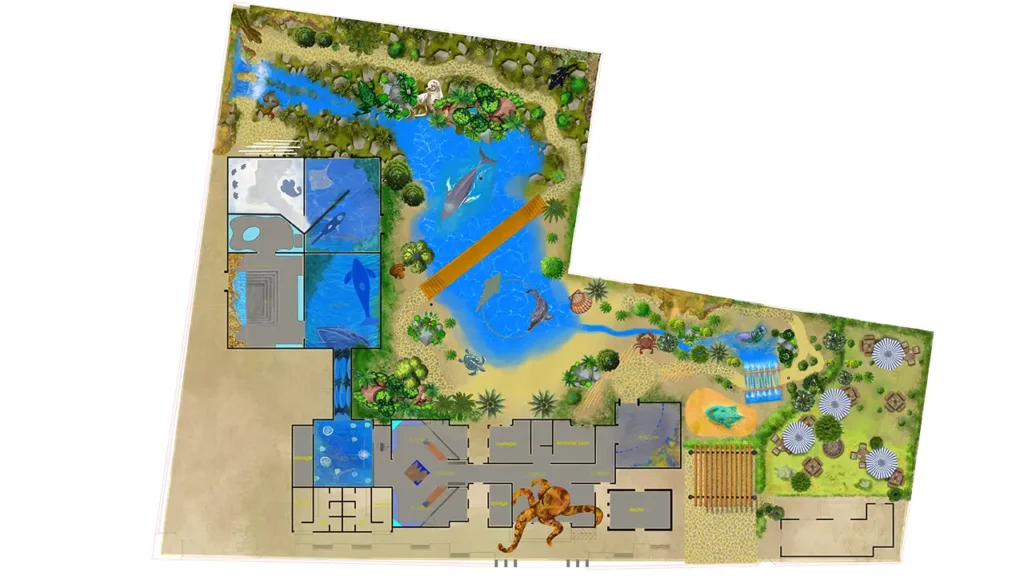
- Why Should You Design a Plan for a Theme Park?
- What are the Defining Characteristics of a Standard Theme Park Plan?
- Indoor, Outdoor, and Hybrid Theme Parks
- Walking Space vs. Ride-Based Theme Parks
- Activating the Audience’s Five Senses in a Theme Park
- What does the theme park plan design encompass?
- What are the Main Challenges Associated with Designing a Theme Park Plan?
- What Measures are Taken to Prevent Audience Boredom in a Theme Park?
- What is the Minimum Space Required to Design a Theme Park?
- Does the design of a theme park plan change based on the age, gender, and nationality of the audience?
- How does one order a theme park plan design?
- How Long Does It Take to Design a Theme Park on Average?
- How Much Does It Cost to Design a Theme Park on Average?
- Can Theme Park Plans Be Reused in Other Locations, or are They Site-Specific?
- Contact us for designing a theme park plan
Why Should You Design a Plan for a Theme Park?
The process of designing a theme park plan is quite similar to designing a museum plan, with the key difference being that a theme park is specifically engineered to be more engaging and entertaining. Developing a theme park plan is profoundly important because it significantly enhances the quality of the audience’s experience—by several degrees—when they visit. In fact, if we were to compare two otherwise identical theme parks, the one with a dedicated plan and scenario will invariably deliver a superior experience to its visitors. Consequently, the score and rating that the audience gives to the theme park will rise, attracting more visitors.
It is worth noting, however, that a comprehensive plan may not be necessary for locations with a very small footprint. For instance, a single room less than a hundred square meters, built as an ancillary part of a larger complex, doesn’t require the design of an intricate plan and may not even have one. But for complexes exceeding 200 square meters, utilizing plan and scenario design services is essential. This is critical for managing the theme park’s layout, the placement of installations, the audience’s flow, and the duration of the visit, thereby ensuring maximum efficiency and a positive visitor experience.

What are the Defining Characteristics of a Standard Theme Park Plan?
Like other commercial and entertainment developments, theme parks include necessary technical components such as electrical, mechanical, lighting, and partitioning infrastructure. However, the main difference in theme parks lies in the design of the scenario and the visitor’s journey, which holds great importance for us. Theme park designers always establish a foundational theme for the décor, the positioning of installations, and the audience’s route. This focus is vital for accurately predicting the scenario based on the audience’s needs, the expected visit duration, the amount of walking involved, and the desired atmosphere.
Indoor, Outdoor, and Hybrid Theme Parks
Generally, theme parks are categorized into three broad types: Outdoor, Indoor, or a Hybrid combination. For instance, the types of installations used in open-air spaces can never be relocated indoors. Typically, natural elements are incorporated into outdoor spaces to make the walking experience more pleasant.
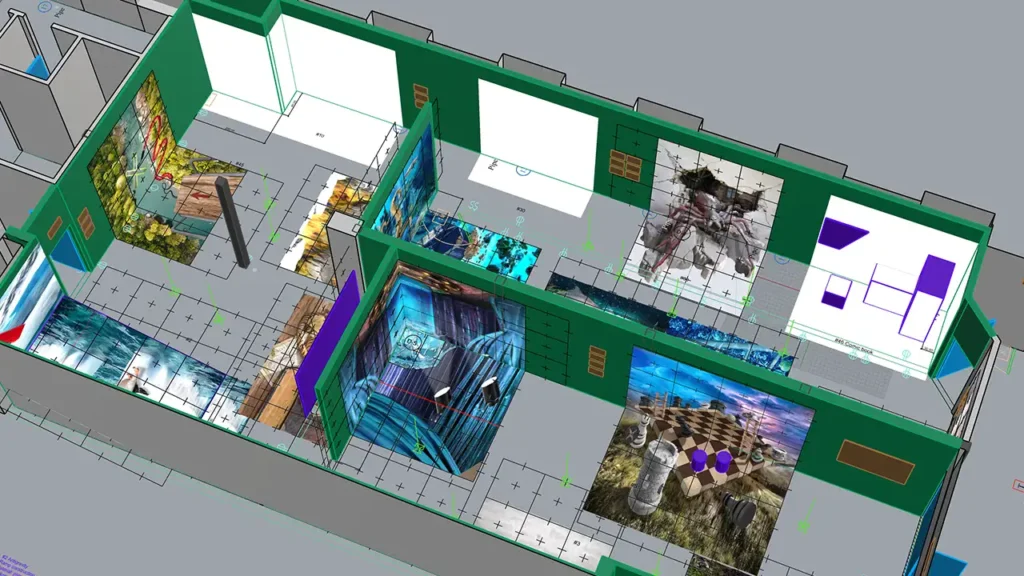
Walking Space vs. Ride-Based Theme Parks
In terms of the style of visitation, theme parks are also divided into two principal categories. The first is the Walking Space, where the visitor traverses the path we designed for them on foot. The second is the Ride-Based model, where the audience is transported by a vehicle from start to finish and generally cannot move through the path independently. In the ride model, the designer has greater freedom to arrange the installations such that the audience encounters them at the optimal angle and time, maximizing their enjoyment. Additionally, since the audience does not interact directly with the installations in the ride model, they tend to be more durable.
Nevertheless, designing the ride model also presents its own set of challenges. For instance, the mechanical devices are prone to wear and tear and must adhere to a specific design and implementation standard. Furthermore, utilizing rides introduces space constraints, as easy exploration and full use of every part of the space are not possible. Therefore, larger spaces are typically required. The Walking Space model is itself subdivided into two categories: Open Space or a Walking Through Path, each with its unique benefits and drawbacks. In the Open Space model, the audience can decide where to go and how to move around, while in the Walking Through Path model, the audience’s route is strictly defined. Sometimes, a combination of the two is used. For example, in the Roya Park project, we designed a mix of open space and session-based sections, allowing the audience some free movement within the space while keeping sections distinct. In contrast, in the Zombie Hotel project designed by our team, the audience has no option to return to a previous stage and must continuously move forward.
Activating the Audience’s Five Senses in a Theme Park
Understanding which of the audience’s senses you intend to engage—sight, hearing, smell, taste, and touch—is extremely important. Some theme parks, much like museums, focus solely on the audience viewing the exhibits and do not engage the other senses. This results in a one-sided experience where we observe little audience reaction. But experience-based theme parks are different; the audience actively participates in the narrative and performs an activity. The simplest form of engagement is for the audience to take a picture with the project, thus becoming a part of it. For example, outdoor theme parks tend to be more interactive, allowing the audience to touch the installations and make changes. Experience Museums are a type of theme park that centers on the audience’s personal experience and does not necessarily adhere to a specific theme. Similarly, Science Museums focus on familiarizing the audience with the scientific realm and providing them with relevant hands-on experiences

What does the theme park plan design encompass?
The initial stage requires us to possess a complete and accurate map of the working location. For smaller projects, a precise 3D plan is needed, while large-scale projects demand a topographic map, green space map, and even a map of adjacent areas. To achieve maximum space utilization, it is essential to be aware of all existing basic facilities, installations, infrastructure, and amenities. Some installations are structured so that the audience only sees 20% of the work, yet the installation itself requires a larger footprint to be executed correctly and accurately. To construct these, we often utilize underutilized areas, such as utility spaces, to minimize costs and boost productivity. This strategy allows us to construct more efficient theme parks even within smaller spaces.
In the subsequent stage, we review the list of project variables. Based on the data we have, we determine which themes are most suitable for the project and appealing to the audience in that particular area. We assess the installations based on budget, size, material, and the overall theme of the space to arrive at the optimal solution for theme park implementation. During the planning phase, we map out the path, defining how visual or experience-oriented each section is and the amount of time the audience should spend there.
After the scenario is finalized, the first implementation phase commences, where all the various sections, including decoration, facilities, etc., are broadly specified within the theme park space. This map is not entirely precise. In the second phase, the final detailed design is created, where every project detail is specified to ensure complete feasibility. The following stage involves the design of the installations themselves. Since these installations are constructed using different materials and techniques, their construction methodologies vary, necessitating a detailed design plan for each.
To optimize the timeline, construction and site preparation operations are initiated concurrently with the start of Phase One. Failing to do so results in significant time loss, and the final cost of construction and equipping the project will be much higher than estimated. Furthermore, this method provides assurance to the client that the plan they approved on paper is indeed being realized and that everything is progressing according to schedule.
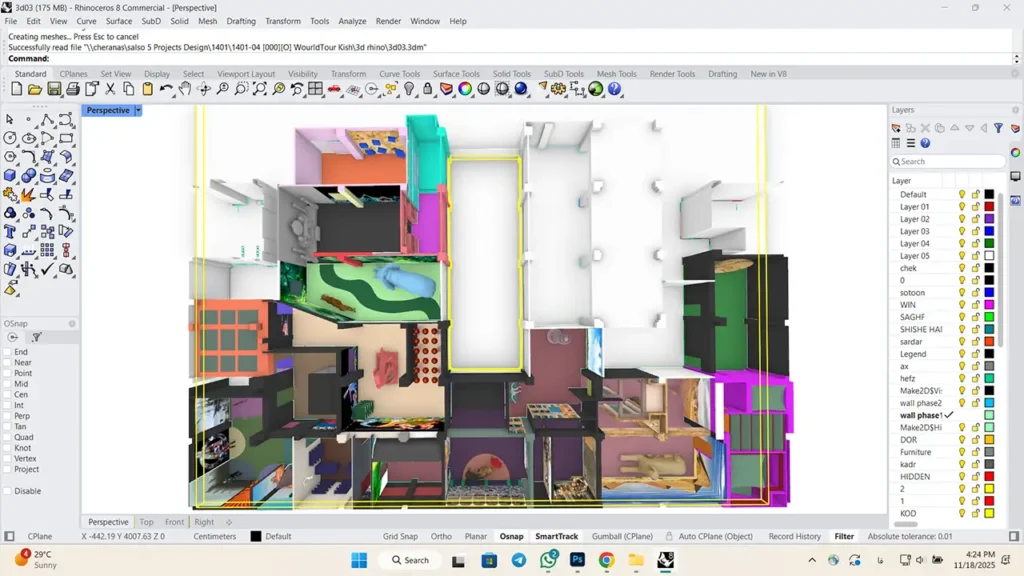
What are the Main Challenges Associated with Designing a Theme Park Plan?
Designing the plan is one of the most crucial and engaging parts of building a theme park. The most important challenge in plan design is obtaining accurate and precise information about the geographical location and achieving the best possible outcome that aligns with the employer’s vision, all to ensure a pleasant audience experience. It can be argued that interacting with the employer and reaching a mutually agreed-upon decision is the most difficult part of the venture, as we must deliver a high-quality result while adhering to a specific budget. It is critically important that the employer feels a positive rapport and trusts the design and construction team, allowing the team to leverage their creativity to deliver their best work.
Finally, the financial aspect of the endeavor presents another difficulty. If the financial conditions are not well managed, it will inevitably have a negative impact on the final result.

What Measures are Taken to Prevent Audience Boredom in a Theme Park?
Based on the overall theme of the theme park, there are various strategies for creating entertainment. For example, if the theme park space is intended to be frightening, we can employ specific criteria and strategies to effectively scare the audience so that they remain engaged and entertained until the moment they exit. Of course, we can also customize the installations to be more attractive based on the audience’s general preferences. The arrangement and sequencing of the installations are also highly important; they should be spaced and ordered in a way that keeps the audience entertained throughout the journey, avoiding the mistake of placing all the best installations together at the very beginning.
What is the Minimum Space Required to Design a Theme Park?
The required space is entirely dependent on the subject and theme of the theme park. Some themes and installations necessitate high vertical clearance. Therefore, the themes must be selected first, and the required space determined accordingly. In some cases, the employer specifies the available space, saying, for instance, “I have a 500-square-meter space,” and we design around that constraint. The smallest theme park we have built was compactly constructed within a usable space of approximately 150 square meters. Generally, the optimal space for building a theme park averages about 700 square meters.
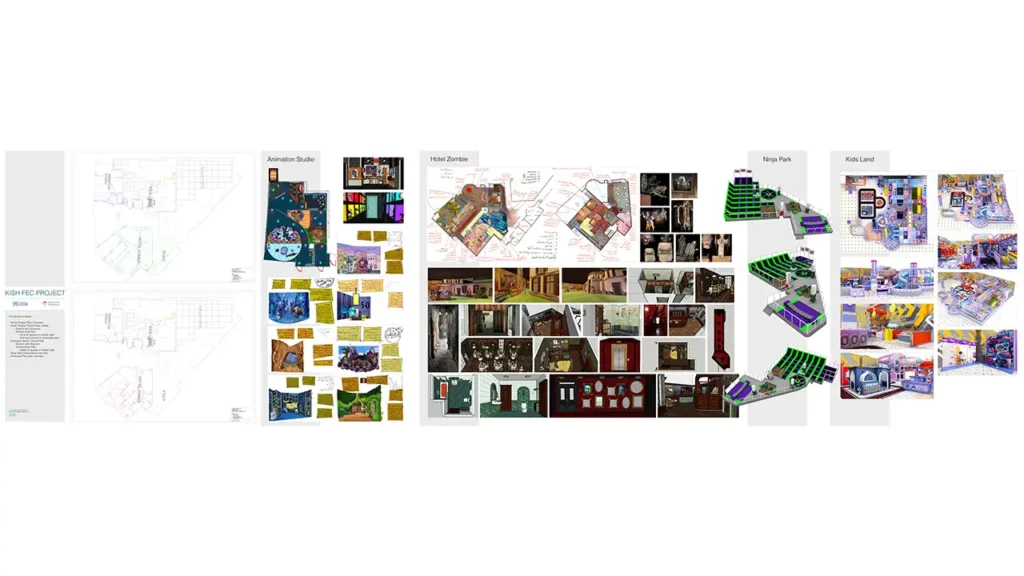
Does the design of a theme park plan change based on the age, gender, and nationality of the audience?
Yes, naturally, the age, gender, and nationality of the target audience significantly influence the theme park plan’s design. We optimize the theme park design based on the culture, nationality, age, and gender of the audience. For instance, if the theme park is to be located in Western Europe, we might emphasize the artistic component of the installations, whereas the approach would be somewhat different in East Asia, the Middle East, or America. While global audiences are diverse, the prevailing regional taste must always be considered.
How does one order a theme park plan design, and what key considerations should be made when placing an order?
The best course of action is to arrange an initial consultation session where you can present your foundational information and desires, allowing us to collaboratively establish a general plan. It is crucial for us to know whether you already possess a specific location or if you plan to search for a location based on the design we create. We can partner with you from the very inception of the project, handling everything from site selection, market research, theme selection, plan design, mapping, and so forth. If on-site presence is not possible, we can still assist through consulting contracts, providing advisory services. We have extensive experience in planning, scenario design, and understanding audience behavior, enabling us to offer sound advice and recommendations during the consultation session.

How Long Does It Take to Design a Theme Park on Average?
The answer to this question is contingent on various factors. For example, if there is a severe time constraint for project implementation, treating the work as an urgent “force majeure” task, the cost of design and implementation will increase. Otherwise, on average, constructing a standard theme park from the project’s commencement to its final completion takes approximately one year. However, the speed of work can be accelerated. For instance, we completed a 1,500-square-meter project in a concentrated effort over 8 months. Nonetheless, to ensure cost optimization, it is advisable to execute the work with careful planning over the course of about a year. Of course, depending on the area and the complexity of the installations, a 600-square-meter project might be completed in about 4 months. All these variables can be finalized during a consultation session.
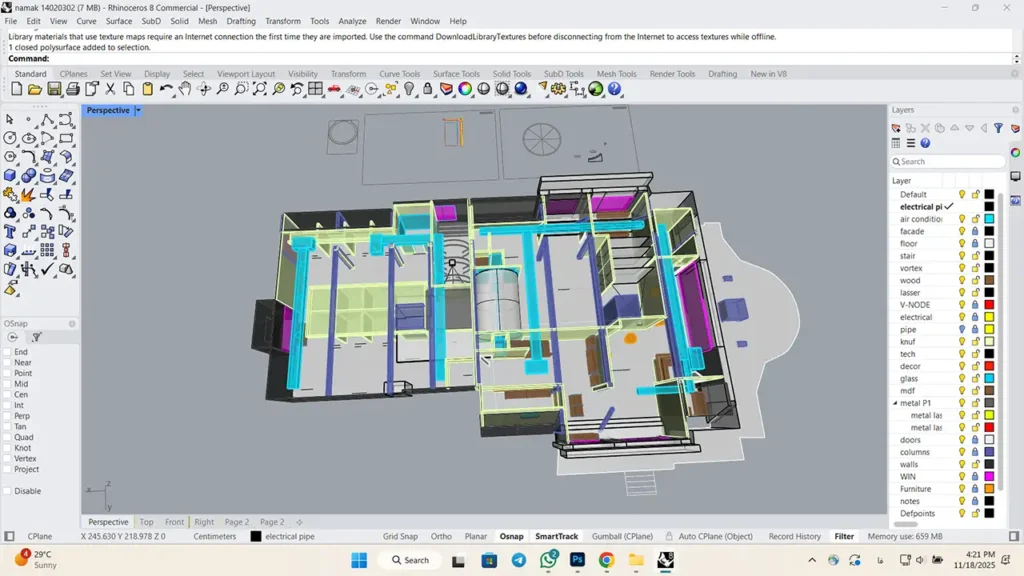
How Much Does It Cost to Design a Theme Park on Average?
The cost of design fluctuates based on the style, size, and complexity of the installations. It depends on the theme park’s area, whether it is indoor or outdoor, and various other parameters. Based on our varied experiences, we have established a general cost range, estimating that standard theme parks will cost between $300 and $1,500 per square meter. This figure excludes construction costs and is subject to variation based on geography and the specific contractor. We can provide a comprehensive project solution for you, covering everything from designing the plan and scenario to supervising the theme park’s construction process. In this complete service model, approximately 30% of the total cost is typically allocated to design and supervision. Alternatively, you can utilize only our consulting and design services and manage the construction work with the assistance of local contractors. To explore this, we recommend reviewing our portfolio to gain inspiration. Following that, you can schedule a consultation to provide us with your specific information so that we can offer the most informed advice.
Can Theme Park Plans Be Reused in Other Locations, or are They Site-Specific?
Our primary recommendation is that each project should possess a unique design to ensure the audience has a truly distinctive experience. However, for open-space layouts, we do have the capacity to reproduce elements of previous plans. Opting for reproduction can help reduce design costs. We hold the necessary licensing for these existing plans, and you can acquire them at a lower cost with a reduced risk percentage. We maintain various themed park packages whose plans you can review and purchase.

